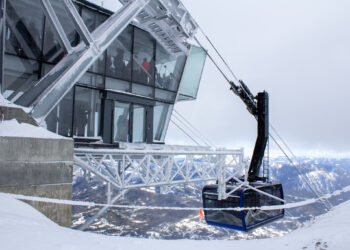By Kristen Inbody Great Falls Tribune
GREAT FALLS (AP) – For the miners who found gold along Warm Spring Creek Canyon in 1879, the toughest part may have been keeping silent about their find while they wintered in Junction City along the Yellowstone River.
“They kept an absolute lid on this thing,” historian Jerry Hanley of Maiden said.
They assemble a team to work to return to the site and managed to discretely slide out of town to make their way back to the Judith Mountains north of Lewistown.
“Pretty soon a lot of people started coming” and the Judiths were swarming with miners in the 1880s to early 1900s (and with those who “mine the miners”).
“Warm Springs Creek Canyon was a labyrinth of downfall. You couldn’t hardly ride a horse through it,” Hanley said. “I can’t believe how fast they built even though everything had to be freighted in from the river, and that included the salt shakers, the windows, the chewing tobacco, the mining equipment and all the iron.”
Hanley’s grandfather came to Maiden in 1895, a socialist active in the miner’s union, who worked his own mines and who ran an assay office.
The Lewistown Area Chamber of Commerce and Hanley teamed up for a new brochure “Ghost Towns & Gold Mines,” which goes into some depth on Giltedge, Maiden, Fort Maginnis and Kendall, while also mapping long-lost ghost towns such as Nelsonville, the first tent city in the Judith Mountains, and New Year, which is down to a few foundation ruins on private property.
GILTEDGE
A house of ill repute is among the few buildings still standing in Giltedge, also spelled Gilt Edge.
Western legend Calamity Jane once walked these streets. Thousands did. This town was as big as Fort Benton is now.
Echos linger to point to what this town was like 110 years ago. There’s some stone walls, a brick building, a wooden jail.
In 1883, W.E. “Limerick” Wilson found gold on the east slopes of the Judith Mountains and 10 years later, the town of Giltedge was born.
The first (maybe second) to use cyanide processing, the Giltedge mine started using the chemical in 1892. Mining ended in 1991, and visitors can see cuts and tailings northwest of Giltedge. The area produced about 100,000 ounces of gold or more than 3 tons (that’s the weight of one blue whale tongue).
Giltedge is just a couple miles north of U.S. Highway 87, east of Lewistown.
KENDALL
If you only go to one Fergus County ghost town, pick Kendall for the interpretive signs and quality of the ruins.
It’s in the North Moccasin Mountains northwest of Lewistown. Electrified early, Kendall boomed in the first decade of the 1900s, peaking at 1,500 people.
A particular is the stone walls of the former Scotch Presbyterian church. They were the largest ethnic group in Kendall and the only congregation that built a church, though as the town declined from 1911, the congregations began sharing the building and the only ministers from then were traveling ministers.
In 1908, the town opera house started showing silent movies at the same time as the church service, and people voted with their feet for the movies, leading to the pastor calling movies a “detriment to the character of young boys and girls.”
The two-story, $10,000 Kendall “Bank Building” is made of local sandstone and formerly hosted a post office, bank, mercantile and hardware store.
Near the bandstand is a boulder with holes drilled into it, the legacy of a drilling contest on Miners Union Day in 1920.
Hilger came along in 1911 and had the advantage of being on the rail line. People moved to Hilger and onto homesteads, sometimes dragging along Kendall buildings with them, such as the former Hilger School.
North of Lewistown, turn west at the town of Hilger (after checking out the school) onto North Kendall Road. Go north along Last Chance Creek about 7 miles to the town.
MAIDEN
Imagine the rumble of freight wagons and stage coaches, raucous miners spilling out of saloons, shopkeepers and clerks bustling around 154 buildings and the grind of stamp mills.
Maiden was a bustling town in the 1880s, peaking at 1,200 people by the end of the decade. A 1905 fire destroyed most of the town, though it held on to the last saloon, which closed in 1918, the post office, 1921, and the school a few years later.
Hanley said the 1905 fire began with a man who flipped a cigarette behind a saloon while he walked a woman home from a dance.
“It wiped out most of the business district. The town was just ashes,” he said.
Storekeeper Natalie Belanger (who also had stores in Giltedge and Kendall) had an $80,000 loss in the fire and no insurance. She lost two sons in Maiden, one who committed suicide after apparently rustling livestock and another who died at age 4 while she was on a buying trip for the store. She died at age 104.
Hanley wrote that the most recent gold mining in the area happened last year, bringing the total take of Gold Hill to 400,000 ounces since the 1887 discovery of gold near the head of Warm Spring Creek Canyon.
There are 20 or so buildings in Maiden, from ruins that are little more than rubble to historic buildings turned into modern homes.
Go north of Lewistown on U.S. Highway 191. Before Hilger, turn at the sign for Maiden Road and follow Warm Spring Canyon to Maiden. From Maiden, continue east/southeast through the narrow, dramatic Maiden Canyon to Gilt Edge and Fort Maginnis.
The area around Maiden also was home to several other mining camps, such as Spotted Horse and New Year. Andersonville was established in 1881 and later the site of a US Air Force radar base and then a Bible college.
FORT MAGINNIS
It would have been easy to miss the ruins of Fort Maginnis as the sun set along Ford’s Creek.
But it helps to know what to look for, which isn’t much. Look for rectangular depressions. These old foundations hint at what was once a complex of enlisted men’s quarters, a commissary store, a bakery, guardhouse, clerk office, a chapel, a school, a blacksmith shop, a hospital, a post office and more.
The fort dates from the Indian Wars era, established in 1880 and in 1886, 266 enlisted men and officers were serving there, with as many as 500 people at the fort, Sam Phillips and Hanley wrote in the brochure. Telegraphs helped the soldiers battle the bandits.
One tough winter when a mine closed and didn’t make payroll, soldiers had to deliver rations into Maiden to keep the peace.
The fort was open until 1890, when several of the buildings were moved into Lewistown and Giltedge.
On a prominent hill overlooking the fort ruins is a cross marking the fort cemetery. Among the graves is one for E.C. “Teddy Blue” Abbott, a famous cowboy and author of We Pointed Them North: Recollections of a Cowpuncher.”
The fort is 25 miles miles northeast of Lewistown. From U.S. Highway 87, turn north on Gilt Edge Road, then onto Black Butte Road and east onto Fort Maginnis Road.
The road crosses Ford’s Creek, which sometimes must be forded by foot. The ruins are about a half mile past that. It’s a beautiful place to explore and state lands.
Copyright 2017 Associated Press. All rights reserved. This material may not be published, broadcast, rewritten, or redistributed.













